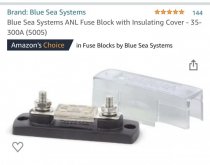The fuse that goes from my battery positive to my bus bar positive blew. In fact it melted the container the plastic fuse was in, but the metal piece between the fuse did not break?
I’m wondering if the 300 amp fuse was the right size? Anybody have an idea if I was using the right type of fuse. ?
Anyway I have eight battle born batteries. Hundred amp hour 12 V batteries wired in series parallel for 24 V. Everything in my system is 24 V.
Thanks, Jon
I’m wondering if the 300 amp fuse was the right size? Anybody have an idea if I was using the right type of fuse. ?
Anyway I have eight battle born batteries. Hundred amp hour 12 V batteries wired in series parallel for 24 V. Everything in my system is 24 V.
Thanks, Jon





